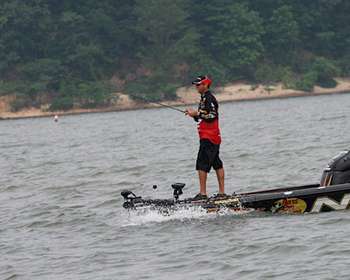
The fastest path between two points is a straight line. So it's no surprise that Kevin VanDam, a noted power fisherman capable of covering vast quantities of water with lightning speed, is a big fan of straight lines.
However, VanDam's favorite lines have nothing to do with speed; they have to do with mud. "I love fishing mudlines," proclaims the 2009 Toyota Tundra Bassmaster Angler of the Year. "I'm always looking for them. It doesn't matter if it's the middle of winter or summer, mudlines are a magnet for bass." VanDam's affinity for mudlines boils down to one thing — it positions the bass.
"Without a doubt, when you get a windy day on a clear lake and there's a mudline coming off a point, that's a great ambush point for bass," he explains. A mudline develops when current, wind or wave action creates a distinct line where muddy water and clean water meet.
It's in the first few feet of muddy water where bass have a decided edge over the baitfish that are drawn to an area to feed on plankton. "In low-light conditions, bass have an advantage over baitfish; mudlines simulate a low-light situation," explains VanDam. "There's turbidity in the water and the wind is creating current, so all these things help bass ambush forage," he continues. When targeting mudlines, VanDam focuses on the upper half of the water column.
His go-to offerings include a spinnerbait and a Strike King Red Eye Shad, both of which allow him to cover water and control the depth of his retrieve. VanDam begins to dissect a mudline by casting into the dirty water and pulling it into the clear water.
The majority of his bites come when his bait is still in the dirty water or as it approaches the clean water. "The bass will be positioned right on the edge of the mudline or a lot of times they will be right in the mud itself. You usually won't find them in the clearer water because the bass knows that it has an advantage in that muddy water," VanDam says.
Generally, when there are mudlines there is also wind, which creates current. "The bass will be facing into the current so I like to move my bait across the mudline at a 45-degree angle with the wind and the mudline. That way, I'm pulling my bait right in front of the bass' face," he explains.
The Michigan pro is quick to point out that the more defined mudlines generally produce better results. "If it's kind of muddy and mixed, I've never found those areas to be as good as distinct transitions," he says.
(Provided exclusively to BASS Insider by Z3 Media)




